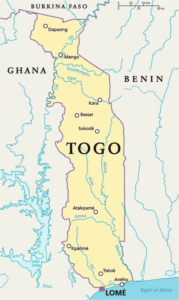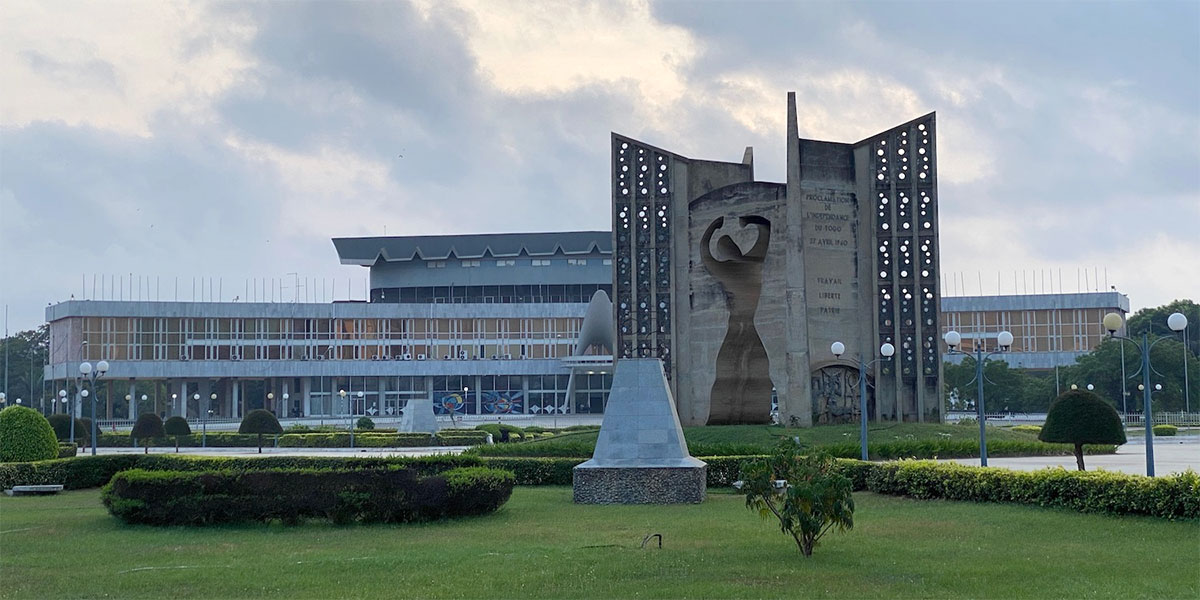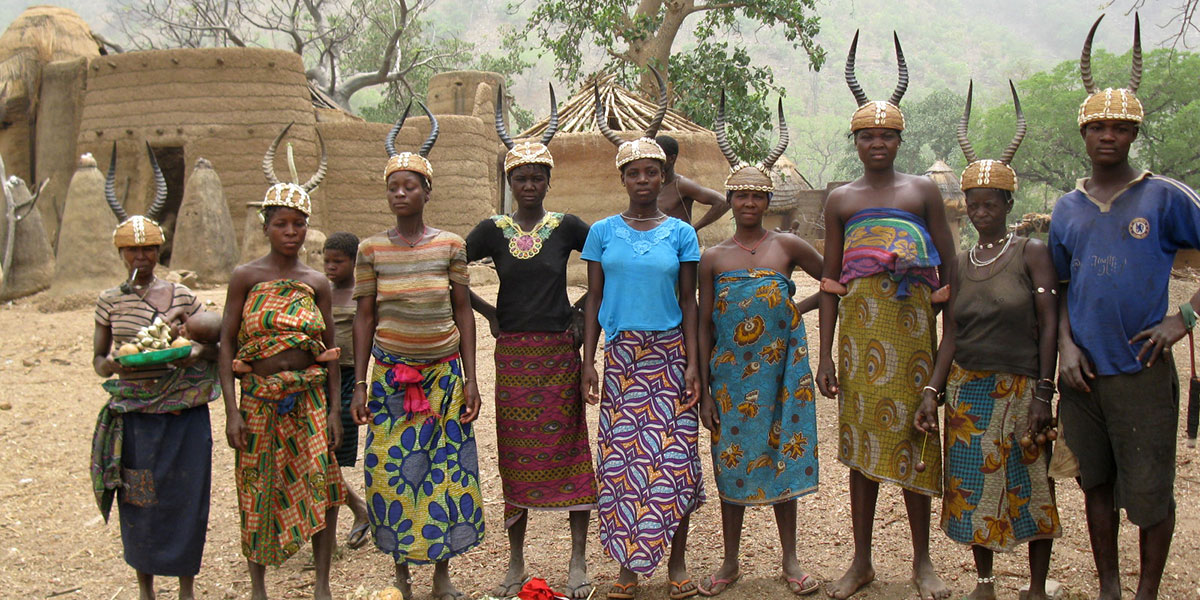Discovering Togo
 Togo, also known as the Togolese Republic can be found on the west coast of Africa. It has land boundaries with Burkina Faso to the north, Benin to the east, Ghana to the west, and the south is bordered with the Gulf of Guinea (Atlantic Ocean).
Togo, also known as the Togolese Republic can be found on the west coast of Africa. It has land boundaries with Burkina Faso to the north, Benin to the east, Ghana to the west, and the south is bordered with the Gulf of Guinea (Atlantic Ocean).
Togo is an interesting tiny sliver of a country with dense forests, savannah, coastal lagoons, long sandy beaches and swampy plains. It is traversed in the centre by a chain of hills, the Atakora Mountains, extending roughly southwest into Ghana, north eastward into Benin and averages about 2,300 ft in height. The highest elevation is Mt. Agou (3,235 ft). To the north and west of these hills the Oti River drains in a south westerly direction into the Volta River, which constitutes a part of the boundary with Ghana. To the north of the Oti River valley lies gently undulating savannah country. From the southern spur of the central hills a plateau stretches gradually southward to a coastal plain. The 31 mile (54 km) long coastline consists of flat sandy beach thickly planted with coconut trees and partially separately from the mainland by a series of lagoons and lakes which are former estuaries of several rivers.

Climate
Togo has a humid, tropical climate, but receives less rainfall than most of the other countries along the Gulf of Guinea. In the south there are two rainy seasons, from March to early July and in September and October. The heaviest rainfall occurs in the hills of the west, southwest, and center, where the precipitation averages about 150 cm (60 in) a year. North of the Togo Mountains there is one rainy season, lasting from April to August.
People
Togo is neither densely populated nor over populated. Togo’s size is just less than 57,000 square kilometres (22,000 sq mi). It has a population of more than 6,600,000 people, making it the 107th largest country by population in the world. This population figure indicates that Togo has a very high growth rate, since the population grew by more than 5 times between 1961 and the year 2003.

The official language is French, but many other languages are spoken. In Togo, there are about 40 different ethnic groups, the most numerous of which are the Ewe in the south (46%) (Although along the south coastline they account for 21% of the population), Kotokoli and Tchamba in the center, Kabyé in the north (22%). Another classification lists Ouatchis (14%) as a separate ethnic group from the Ewe which brings the proportion of Ewe down to (32%). However, there are no historic or ethnic facts that justify the separation between Ewes and Ouatchis. The Ouatchis are a sub-group of the Ewe just as the Anlo in the Republic of Ghana are a subgroup of the Ewe ethnic group. Mina, Mossi, and Aja (about 8%) are the remainder; and under 1% are European expatriates who live in Togo as diplomats and for economic reasons.
Despite the influence of Christianity, a lot of people still follow native animistic practices and beliefs. In Kloto area, the people are known for skillful woodcarving. They are mainly engaged in carving rings from a particular wood for marriage purposes.
History of Togo
Before the influx of the Portuguese in the late 15th century, various tribes migrated into the country from different directions because of the pressure of colonial rule in neighbouring countries. The Voltaic peoples and the Kwa were the earliest known inhabitants. The Ewe followed in the 14th century and the Ane in the 18th century.
The Ewe ethnic group came from Nigeria and Benin, and the Guin and Mina tribes came from Ghana. In the 16th century, slave trade began and the Europeans found Togo. The dense population along the coast prompted the Europeans to call Togo the “slave coast”.
The Danish claimed the land in the 18th century, but by 1884 it was established as a German colony (Togoland). In an 1884 treaty signed at Togoville, Germany declared a protectorate over a stretch of territory along the coast and gradually extended its control inland. This became the German colony Togoland in 1905.
After the German defeat during World War I in August 1914 at the hands of British troops (coming from the Gold Coast) and the French troops (coming from Dahomey), Togoland became two League of Nations mandates, administered by the United Kingdom and France.
After World War II, these mandates became UN Trust Territories. The British portion voted for incorporation with Ghana. The French portion became Togo, which declared its independence on April 27, 1960.
Cuisine
It is not surprising that the food choices in Togo are a reflection of the many ethnic groups that share the country. There are European meals for tourists who may not like the local dishes. Togo’s local dishes include:
Fufu: made from boiled yam mashed to form a dough. It is eaten with soups. Locally available fresh vegetables are used for making the sauce dips. Non vegetarian sauce items are made from meat, poultry and fish.
Akume/pastes: is made from ground maize and flour mixed with water to form dough. It is also eaten with different kinds of soup.
Tchakpallo: This is a mixture of fermented millet and palm wine, served instead of German beer in traditional settings.
Kokonte: This is a sort of a pates made from the locally grown Cassava. Millets and sorghums which are cheaper and can be grown in more arid regions.

Riz Sauce Arachide : peanut butter sauce eaten with rice. A healthy delicacy worth tasting.
Lemonade and Bissap juice are the most popular drinks. There are many bars almost around all corners in Lomé where you will be able to have a beer.
Visa & Immigration
Visa regulations can change at any time and Embassies do NOT always update us when they change their entry requirements – we strongly advise you contact your nearest embassy to find the latest information on visa requirements for Togo.
Public Holidays
- 1st January – New Year’s Day
- 13th January – Liberation Day
- 24th January – Anniversary of failed attack at Sarakawa
- 24th April – Day of Victory
- 27th April – Independence Day
- 1st May – Labour Day
- 15th August – Assumption
- 24th September – Anniversary of failed attack at Lomé
- 1st November – All Saint’s Day
- 25th December – Christmas Day
- Moveable holidays – Easter Monday
-
- Variable Islamic holidays
Travel Insurance
If you need medical care whilst in Togo, it is best to be aware that medical providers may not accept payment through your insurance company. In these circumstances you will have to pay in full after your treatment and file a claim with your insurance company for reimbursement. Therefore you should have access to cash, either from a credit card or by wire transfer. If you need assistance contact the country’s local embassy or representative.
To be compensated you must be treated by licensed medical personnel and provide your insurance company with proper documentation and receipts.
It is advisable to always ensure you have a comprehensive travel insurance policy which covers you for repatriation to your home country.
Several airlines offer regular flights to Lomé. But flying directly to Togo is often more expensive than flying to Accra in neighbouring Ghana.


